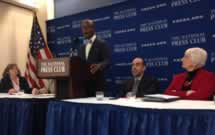Educators, librarians discuss how schools and libraries can respond to the ‘second wave of the digital divide’
 Washington, D.C. — Barbara Stripling, president of the American Library Association, said students, teachers, and librarians are facing “a silent dilemma.”
Washington, D.C. — Barbara Stripling, president of the American Library Association, said students, teachers, and librarians are facing “a silent dilemma.”
Imagine, she said, you’re one of two students sitting next to each other in the same classroom, receiving the same assignment. The homework requires some online research. One student, who has had a computer as long as she can remember, goes home that night and gets to work.
You, the other student, are from a lower-income family and have never had access to a computer. You eventually are able to sneak in an hour or two at the public library, but as you stare at the empty web browser, you don’t even know where to begin.
“You’ve never had that kind of access,” Stripling said. “No one has ever explained to you what good or bad information is online. You turn in your assignment, and that other student gets a good grade, and you don’t.”
Stripling was one of three panelists who spoke at the National Press Club on May 6 about the “second wave of the digital divide.” The first wave is the lack of equal access to computers and the internet.
The second wave comes when the students who lack access grow up without ever learning necessary technology skills.
(Next page: ‘A national crisis’)
They may be unable to complete homework assignments or tell the difference between a random blog and a reputable source for research papers. They may not know how to search for jobs or how to find information about going to college.
Seventy-five percent of teachers are assigning homework to students that require a “digital environment,” Stripling said, but only 54 percent of teachers say they believe all of their students have access to those tools.
“The school library then becomes the most powerful place for them,” she said. “School librarians are in charge of that training, of providing those tools. That is the responsibility of the school librarian.”
But not all school librarians are qualified to do this sort of training, Striping admitted. Too many public schools do not hire state-certified librarians, she said, instead relying on well-intentioned but often unqualified members of their community.
About one-third of public school libraries don’t have full-time, state-certified librarians, according to a 2013 report authored by Kathy Rosa, director of the ALA’s Office for Research and Statistics. Fifty-six percent of public charter schools do not employ state-certified librarians.
In California, there is just one library media specialist for every 7,000 students.
“It’s a national crisis,” Stripling said. “There are entire communities that have absolutely no certified librarians.”
Libraries themselves may also not be up to the challenge, the panelists said.
“Many libraries are built for transaction, not transformation,” said Richard Reyes-Gavilan, executive director of the District of Columbia Public Library.
(Next page: A lack of funding)
If a public library even has a space for computers at all, he said, the labs tend to just be in hastily converted rooms or basements. He described the environments as “oppressive” and questioned how students could learn in them.
Even large public library systems like the one in D.C. can have trouble staying technologically up to date.
“We had Windows 95 until last year,” Reyes-Gavilan said with a laugh, though it wasn’t entirely clear if he was joking. “If you’re on a schedule where you only refresh every 20 to 30 years, that’s an issue.”
Initiatives like ConnectED and the eRate program may help, the panelists said, but libraries simply need more funding to make a difference. While education, and education technology, has been a large part of the Obama administration’s agenda, school libraries have not received the same sort of attention.
The president’s proposed 2015 budget contained no funding for libraries and cut $2 million from the Library Services and Technology Act.
Clarence Anthony, executive director of the National League of Cities, said libraries and schools must do more to remind the public and the government that libraries are a key part in making sure the United States can remain globally competitive.
“Digital literacy is no longer a choice,” Anthony said. “This is a quality of life issue.”
- How to poke the universe - June 11, 2014
- Gaming in education: ‘We don’t need no stinking badges’ - May 23, 2014
- Digital divide, lack of certified librarians ‘a national crisis’ - May 8, 2014

